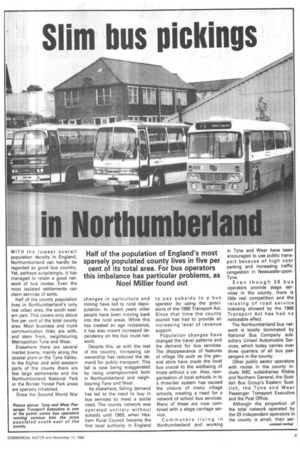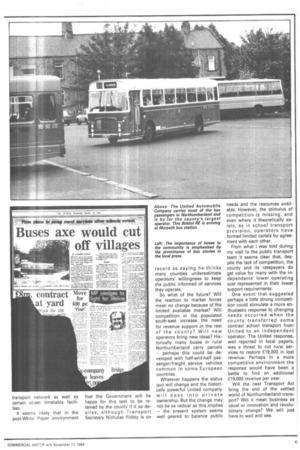Slim bus pickings
Page 43

Page 44

Page 45

If you've noticed an error in this article please click here to report it so we can fix it.
Half of the population of England's most sparsely populated county lives in five per cent of its total area. For bus operators this imbalance has particular problems, as Noel Millier found out
WITH the lowest overall population density in England, Northumberland can hardly be regarded as good bus country. Yet, perhaps surprisingly, it has managed to retain a good network of bus routes. Even the most isolated settlements can claim services of sorts.
Half of the county population lives in Northumberland's only real urban area, the south eastern part. This covers only about five per cent of the total county area. Most business and trunk communication links are with, and stem from, neighbouring Metropolitan Tyne and Wear.
Elsewhere there are several market towns, mainly along the coastal plain or the Tyne Valley. In the higher and wild western parts of the county there are few large settlements and the Northumberland National Park or the Border Forest Park areas are sparsely inhabited.
Since the Second World War changes in agriculture and mining have led to rural depopulation. In recent years older people have been moving back into the rural areas. While this has created an age imbalance, it has also meant increased dependency on the bus route network.
Despite this, as with the rest of the country, increasing car ownership has reduced the demand for public transport. This fall is now being exaggerated by rising unemployment both in Northumberland and neighbouring Tyne and Wear.
As elsewhere, falling demand has led to the need to buy in bus services to meet a social need. The county network was operated untirely without subsidy until 1969, when Hexham Rural Council became the first local authority in England to pay subsidy to a bus operator by using the provisions of the 1968 Transport Act. Since that time the county council has had to provide an increasing level of revenue support.
Population changes have changed the travel patterns and the demand for bus services. The disappearance of features of village life such as the general store have made the local bus crucial to the wellbeing of those without a car. Also, reorganisation of local schools in to a three-tier system has caused the closure of many village schools, creating a need for a network of school bus services. Many of these are now combined with a stage carriage service.
Commuters living in Northumberland and working in Tyne and Wear have been encouraged to use public transport because of high cost parking and increasing traffic congestion in Newcastle-uponTyne.
Even though 36 bus operators provide stage services in the county, there is little real competition and the relaxing of road service licensing allowed by the 1968 Transport Act has had no noticeable effect.
The Northumberland bus network is totally dominated by National Bus Company subsidiary United Automobile Services, which today carries over three quarters of all bus passengers in the county.
Other public sector operators with routes in the county include NBC subsidiaries Ribble and Northern General, the Scottish Bus Group's Eastern Scottish, the Tyne and Wear Passenger Transport Executive and the Post Office.
Although the proportion of the total network operated by the 29 independent operators in the county is small, their ser vices are particularly important and form a large part of the school network. Indeed if buses and coaches were not needed to get the children to school it is likely to that a large part of the county would now be busless and many rural settlements might have been left to the sheep.
The service pattern in the urban south-east of the county is fairly typical of England, with an extensive network of bus services, mostly operating at hourly frequencies. Some trunk routes are more frequent and many of the hourly services are grouped together to give a combined service of greater frequency. Express coaches passing through the county also provide a significant boost to the trunk route network.
If deregulation spurs on bus operators to compete for business in other areas it is probable that they will be most interested in the south-east of the county. If this happens then the all-powerful United might decide that it needs extra resources to fight and win any battles, which could mean the withdrawing of services in the rural part of the county which it is claimed benefit from the dreaded cross-subsidy.
Most services in the main urban area are classified as either intensive or frequent, while in the rural areas they are at best regular and at worst only occasional.
Most of the independent operators have avoided a fight with their nationalised colleagues or even each other. School contracts are often operated in locally agreed areas. Similarly, most operate
in co-operation with United to mutual benefit.
The obvious question is whether this cosy arrangment is in the best interests of the small podulation as well. I understand from County Public Transport Officer Tony Mitcham that most are apprehensive at the prospect of new operators' coming in from the cold and upsetting the balance.
Here again the question is whether such competition exists and whether it will stimulate innovative advances in transport provision or just cause local competition leading to an increased demand for support to keep other services going elsewhere in the county.
With only an identifiable limited demand there are few obvious areas of innovation. Competition seems likely only to offer more of the same. At present in the remotest parts of the county where there are insufficient residents to justify even the most basic of conventional bus services most public transport is provided on school contract buses. These vehicles operate on 49 routes and carry fare-paying passengers in addition to school children when there is room and when no other transport is available. Their priority remains the carriage of school children, however. The county provides revenue support to United on a network basis leaving the operator to cross-subsidise as necessary to cover all of its routes. All operators charge around the same level of fares. Unconventional public transport schemes are relatively rare. One voluntary car scheme was introduced in 1983 to provide access where no other transport is available to medical facilities, including dentists and chiropodists, and for hospital visiting.
County policy for public transport is clear. Like many in Britain it aims to promote the provision of a co-ordinated and efficient public transport system to satisfy the social and economic needs of the community. The county considers it important that each type of transport complements any other and that wasteful duplication is avoided.
In cash terms subsidy in Northumberland has not been increasing every year. It is currently at around £500,000 and has been declining in recent years. The county public transport team helps the operators to keep the public informed of the transport available. It also helps some independents with timetables and provides its own annual guide to the county transport network as well as certain street timetable facilities.
It seems likely that in the post-White Paper environment that the Government will be happy for this task to be retained by the county if it so desires, although Transport Secretary Nicholas Ridley is on record as saying he thinks many counties underestimate operators' willingness to keep the public informed of services they operate.
So what of the future? Will the reaction to market forces mean no change because of the limited available market? Will competition in the populated south-east increase the need for revenue support in the rest of the county? Will new operators bring new ideas? Historically many buses in rural Northumberland carry parcels — perhaps this could be developed with half-and-half passenger/freight service vehicles common in some European countries.
Whatever happens the status quo will change and the historically powerful United company will pass into private ownership. But the change may not be as radical as this implies — the present system seems well geared to balance public needs and the resources available. However, the stimulus of competition is missing, and even where it theoretically exists, as in school transport provision, operators have formed limited cartels by agreement with each other.
From what I was told during my visit to the public transport team it seems clear that, despite the lack of competition, the county and its ratepayers do get value for many with the independents' lower operating cost represented in their lower support requirements.
One event that suggested perhaps a little strong competition could stimulate a more enthusiastic response to changing needs occurred when the county transferred some contract school transport from United"to an independent operator. The United response, well reported in local papers, was a threat to cut rural services to restore £19,000 in lost revenue. Perhaps in a more competitive environment the response would have been a battle to find an additional £19,000 revenue per year.
Will the next Transport Act bring the end of the settled world of Northumberland transport? Will it mean business as usual or innovation and revolutionary change? We will just have to wait and see.












































































































